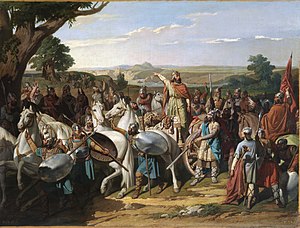
Back الفتح الإسلامي للأندلس Arabic لفتح لإسلامي للأندلوس ARY فتح الاندلس ARZ Conquista musulmana de la Península Ibérica AST Арабско завоюване на Иберийския полуостров Bulgarian মুসলিমদের স্পেন বিজয় Bengali/Bangla Conquesta omeia d'Hispània Catalan Muslimské dobytí Španělska Czech Muslimische Eroberung der Iberischen Halbinsel German Αραβική κατάκτηση της Ιβηρικής χερσονήσου Greek
| Muslim conquest of the Iberian Peninsula | |||||||||
|---|---|---|---|---|---|---|---|---|---|
| Part of the early Muslim conquests | |||||||||
 King Roderic Addresses his Soldiers at the Battle of Guadalete by Bernardo Blanco y Pérez (1871) | |||||||||
| |||||||||
| Belligerents | |||||||||
| Umayyad Caliphate |
Visigothic Kingdom Kingdom of Asturias | ||||||||
| Commanders and leaders | |||||||||
|
Al-Walid ibn Abd al-Malik Musa ibn Nusayr Tariq ibn Ziyad Tarif ibn Malik Abd al-Aziz ibn Musa Uthman ibn Naissa |
Roderic † Theodemir Achila II † Oppas (MIA) Ardo Pelagius | ||||||||

The Muslim conquest of the Iberian Peninsula by the Umayyad Caliphate occurred between approximately 710 and the 720s. The conquest resulted in the defeat of the Visigothic Kingdom and the establishment of the Umayyad Wilayah of Al-Andalus.
During the caliphate of the sixth Umayyad caliph, al-Walid I (r. 705–715), Tariq ibn Ziyad departed from North Africa in early 711 across the Straits of Gibraltar with a force of about 1,700 men to launch a military expedition against the Visigothic Kingdom of Toledo, which controlled the former territory of Roman Hispania.[1][2][3][4] After defeating the Visigothic king Roderic at the Battle of Guadalete in July the same year, Tariq was reinforced by an Arab force led by his superior wali Musa ibn Nusayr and continued northward.
In 713, Theodemir, the Visigothic count of Murcia conditionally surrendered, and in 715, Abd al-Aziz ibn Musa was named the first governor of Al-Andalus, naming Seville as his capital. By 717, the Umayyads had invaded Gaul to launch their first raids into Septimania. By 719, Barcelona and Narbonne had also been captured. From 740 to 742, the invasion was then disrupted by the Berber Revolt, and in 755, when an Abbasid force led by Yusuf ibn Abd al-Rahman al-Fihri landed to claim the territory from the Umayyads.
By 781, Abd al-Rahman I had quashed all rebellions and rivals and consolidated Umayyad rule over an almost wholly reunified Iberia, a presence that would remain until the intensified Pope-backed Reconquista of the mid-13th-century, which was aimed at reclaiming the peninsula for Christianity.[5]
- ^ Cite error: The named reference
:2was invoked but never defined (see the help page). - ^ Nagy, Luqman (2008). The book of Islamic dynasties: a celebration of Islamic history and culture. Ta-Ha Publishers Ltd. p. 9. ISBN 9781842000915.
- ^ Andalusí, Fundación El Legado. Maroc et Espagne: une histoire commune publié par Fundación El Legado Andalusí. Fundación El legado andalusì. ISBN 9788496395046. Retrieved 26 May 2010 – via Books google.
- ^ Cite error: The named reference
:1was invoked but never defined (see the help page). - ^ Fromherz, Allen: The Near West: Medieval North Africa, Latin Europe, and the Mediterranean in the Second Axial Age (2017)